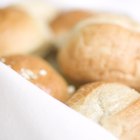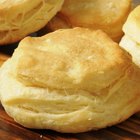Nungning20/iStock/GettyImages
The smell of bread or rolls fresh from the oven is one of the most comforting, homelike fragrances any kitchen can offer. Bread machines and stand mixers have taken much of the physical work out of baking bread, but it still takes a certain amount of time to make and shape bread or rolls. If you'd like to have fresh dinner rolls on the table with less fuss, you can make them ahead of time and refrigerate the dough overnight.
Yeast Roll Basics
Yeast doughs don't require a whole lot of ingredients, just flour, salt and water. Most recipes for dinner rolls add sugar, milk and butter or other fats to the dough, giving the finished rolls a softer texture and richer flavor. Ordinarily, you'd let the dough rise once or twice, then punch it down and form the rolls. After a final rise, they'd go into the oven and bake. However, you can also cover the dough and put it in your refrigerator overnight, slowing its rise. This is a technique that's often used by professional bakers, who refer to it as "retarding" the dough. You can either refrigerate finished rolls, or refrigerate the dough and finish them the next day.
What Happens
Yeasts are living organisms, and like humans they work best when they're at a comfortable temperature. Cold slows them down, which is why many recipes instruct bakers to let dough rise in a warm, draft-free place. If you put your dough in the refrigerator, the yeast will still make it rise, but the rise will take much longer. Professionals and home bakers do this so the rolls will be ready to bake when they're needed. The slow rise also gives the flour's natural enzymes time to convert some of its starches to sugars, improving the flavor and color of the finished rolls.
Adjustments
If your recipe calls for a short rise at room temperature, it uses more yeast than you'll need for a cold overnight rise. Cutting the yeast by a third to half will prevent sour, over-fermented flavors, and will also help slow the rise of the dough. It'll take a few hours for the dough to chill, and during that time it will continue to rise. Often, it will need to be punched down once or twice. That results in misshapen rolls, so many bakers prefer to chill the dough for at least a few hours before shaping them.
Baking
If you've refrigerated the dough without shaping it, remove it from the refrigerator and shape your rolls as usual. They'll take a bit longer to rise than your recipe indicates, but will bake normally. Shaped rolls can go into the oven directly from the refrigerator, if they're fully risen. Otherwise, take them out of the fridge two hours ahead of mealtime to give the yeast a chance to warm up. Bake in a preheated oven as usual, extending their baking time by a few minutes if necessary. Rolls baked from cold dough will often puff more than usual in the oven's heat, creating a lighter, fluffier texture.
Related Articles

Can You Refrigerate Homemade Yeast ...

How to Make Bread Tender
Easy Cinnamon Roll Recipe

How to Preserve Dough That Has Risen
Quick and Easy French Bread Recipe

How to Freeze Brioche

Can I Make Monkey Bread the Night ...

Can Yeast Bread Dough Be Frozen Before ...

How to Make Bread Rise Indoors

How to Make Dough in a KitchenAid Mixer

Can I Make Doughnuts From Frozen Yeast ...

What to Do With Pizza Dough When You're ...

What Happens if You Leave Bread Dough ...

How to Make Dinner Rolls With a ...

How to Bake Bread in a Clay Pot

Can You Proof Yeast in Warm Milk?

What Is Docking Used for in Baking?
Can I Store Biscuit Dough Overnight?

Why Does Bread Drop in the Middle When ...

How to Make Southern Buttermilk ...
References
- On Food and Cooking: The Science and Lore of the Kitchen; Harold McGee
- The Bread Baker's Apprentice: Mastering the Art of Extraordinary Bread; Peter Reinhart
Writer Bio
Fred Decker is a trained chef and prolific freelance writer. In previous careers, he sold insurance and mutual funds, and was a longtime retailer. He was educated at Memorial University of Newfoundland and the Northern Alberta Institute of Technology. His articles have appeared on numerous home and garden sites including GoneOutdoors, TheNest and eHow.